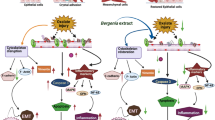Abstract
Urolithiasis is one of the painful multifactorial disorders caused by metabolic abnormalities influencing the composition of body fluids and urine. The bark of Terminalia arjuna (T. arjuna), very well known in Ayurveda for the treatment of cardiovascular diseases, possesses antioxidant and diuretic activity. The present study was undertaken to investigate the antiurolithiatic efficacy of aqueous extract of bark of T. arjuna on oxalate-induced injury to renal tubular epithelial cells. Madin–Darby canine kidney (MDCK) cells were exposed to 2 mM oxalate for 48 h to evaluate the protective effect of T. arjuna aqueous extract on cell viability, CaOx crystal adherence and apoptotic changes caused by oxalate. The results confirmed that oxalate injured MDCK cells were protected by T. arjuna extract. On treatment with a range concentrations, the cell viability increased in a concentration dependent manner. Moreover, the extract prevented the interaction of the calcium oxalate (CaOx) crystals with the cell surface and reduced the number of apoptotic cells. The current data suggests that T. arjuna bark confers a cytoprotective role and based on our results it could be a potential candidate from natural plant sources against urolithiasis.





Similar content being viewed by others
Abbreviations
- T. arjuna :
-
Terminalia arjuna
- MDCK:
-
Madin–Darby canine kidney (cell line)
- CaOx:
-
Calcium oxalate
- COM:
-
Calcium oxalate monohydrate
- DMSO:
-
Dimethyl sulfoxide
- DMEM:
-
Dulbecco’s modified Eagles’s medium
- NCCS:
-
National centre for cell science
- MTT:
-
3-(4,5-dimethylthiazol-2-yl)-2,5-diphenyltetrazolium bromide
- PBS:
-
Phosphate buffered saline
- PS:
-
Phosphatidylserine
- PI:
-
Propidium iodide
References
Aggarwal A, Tandon S, Singla SK, Tandon C (2010) Diminution of oxalate induced renal tubular epithelial cell injury and inhibition of calcium oxalate crystallization in vitro by aqueous extract of Tribulus terrestris. Int Braz J Urol 36:480–488
Allen S, Sotos J, Sylte MJ, Czuprynski CJ (2001) Use of hoechst 33342 staining to detect apoptotic changes in bovine mononuclear phagocytes infected with Mycobacterium avium subsp. paratuberculosis. Clin Diagn Lab Immunol 8:460–464
Cao LC, Honeyman T, Jonassen J, Scheid C (2000) Oxalate-induced ceramide accumulation in Madin–Darby canine kidney and LLC-PK1 cells. Kidney Int 57:2403–2411
Chaudhary A, Singla SK, Tandon C (2010) In vitro evaluation of Terminalia arjuna on calcium phosphate and calcium oxalate crystallization. Indian J Pharm Sci 72:340–345
Cheng HY, Lin CC, Lin TC (2002) Antiherpes simplex virus type 2 activity of casuarinin from the bark of Terminalia arjuna Linn. Antivir Res 55:447–455
Finlayson B, Khan SR, Hackett RL (1984) Mechanisms of stone formation—an overview. Scanning Electron Microsc 3:1419–1425
Jeong BC, Kwak C, Cho KS, Kim BS, Hong SK, Kim JI, Lee C, Kim HH (2005) Apoptosis induced by oxalate in human renal tubular epithelial HK-2 cells. Urol Res 33:87–92
Khan SR (1995) Calcium oxalate crystal interaction with renal tubular epithelium, mechanism of crystal adhesion and its impact on stone development. Urol Res 23:71–79
Miller C, Kennington L, Cooney R, Kohjimoto Y, Honeyman T, Pullman J, Jonassen J, Scheid C (2000) Oxalate toxicity in renal epithelial cells: characteristics of apoptosis and necrosis. Toxicol Appl Pharmacol 162:132–141
Mittal A, Tandon S, Singla SK, Tandon C (2015) In vitro studies reveal antiurolithic effect of Terminalia arjuna using quantitative morphological information from computerized microscopy. Int Braz J Urol 41:935–944
Mittal A, Tandon S, Singla SK, Tandon C (2016) In vitro inhibition of calcium oxalate crystallization and crystal adherence to renal tubular epithelial cells by Terminalia arjuna. Urolithiasis 44:117–125
Moriyama MT, Miyazawa K, Noda K, Oka M, Tanaka M, Suzuki K (2007) Reduction in oxalate-induced renal tubular epithelial cell injury by an extract from Quercus salicina Blume/Quercus stenophylla Makino. Urol Res 35:295–300
Petronelli V, Penzo D, Scorrano L, Bernardi P, Di Lisa F (2001) The mitochondrial permeability transition, release of cytochrome c and cell death. Correlation with the duration of pore openings in situ. J Biol Chem 276:12030–12034
Sarica K, Yagci F, Bakir K, Erbagci A, Erturhan S, Ucak R (2001) Renal tubular injury induced by hyperoxaluria: evaluation of apoptotic changes. Urol Res 29:34–37
Scassellati-Sforzolini G, Villarini LM, Moretti LM, Marcarelli LM, Pasquini R, Fatigoni C, Kaur LS, Kumar S, Grover IS (1999) Antigenotoxic properties of Terminalia arjuna bark extracts. J Environ Pathol Toxicol Oncol 18:119–125
Semangoen T, Sinchaikul S, Chen ST, Thongboonkerd V (2008) Altered proteins in MDCK renal tubular cells in response to calcium oxalate dihydrate crystal adhesion: a proteomics approach. J Proteome Res 7:2889–2896
Tsujihata M (2008) Mechanism of calcium oxalate renal stone formation and renal tubular cell injury. Int J Urol 15:115–120
Verkoelen CF (2006) Crystal retention in renal stone disease: a crucial role for the glycosaminoglycan hyaluronan? J Am Soc Nephrol 17:1673–1687
Verkoelen CF, Van der Boom BG, Schroder FH, Romijn JC (1997) Cell cultures and nephrolithiasis. World J Urol 15:229–235
Verma S, Singh SP (2008) Current and future of herbal medicines. Vet World 1:347–350
Wiessner JH, Hasegawa AT, Hung LY, Mandel NS (1999) Oxalate-induced exposure of phosphatidylserine on the surface of renal epithelial cells in culture. J Am Soc Nephrol 10:S441–S445
Zhang L, Jiang F, Chen Y, Luo J, Liu S, Zhang B, Ye Z, Wang W, Liang X, Shi W (2013) Necrostatin-1 attenuates ischemia injury induced cell death in rat tubular cell line NRK-52E through decreased Drp1 expression. Int J Mol Sci 14:24742–24754
Acknowledgements
This study (SR/SO/HS/132/2010) was financially supported by the Department of Science and Technology (DST), Government of India, New Delhi, India. We would like to thank the Department of Biotechnology and Bioinformatics, Jaypee University of Information Technology, Waknaghat, India for providing the necessary facilities to carry out this study.
Funding
The study was funded by Department of Science and Technology (DST), India (SR/SO/HS/132/2010).
Author information
Authors and Affiliations
Corresponding author
Ethics declarations
Conflict of interest
The authors declare that they have no conflict of interest.
Rights and permissions
About this article
Cite this article
Mittal, A., Tandon, S., Singla, S.K. et al. Cytoprotective and anti-apoptotic role of Terminalia arjuna on oxalate injured renal epithelial cells. Cytotechnology 69, 349–358 (2017). https://doi.org/10.1007/s10616-017-0065-8
Received:
Accepted:
Published:
Issue Date:
DOI: https://doi.org/10.1007/s10616-017-0065-8




